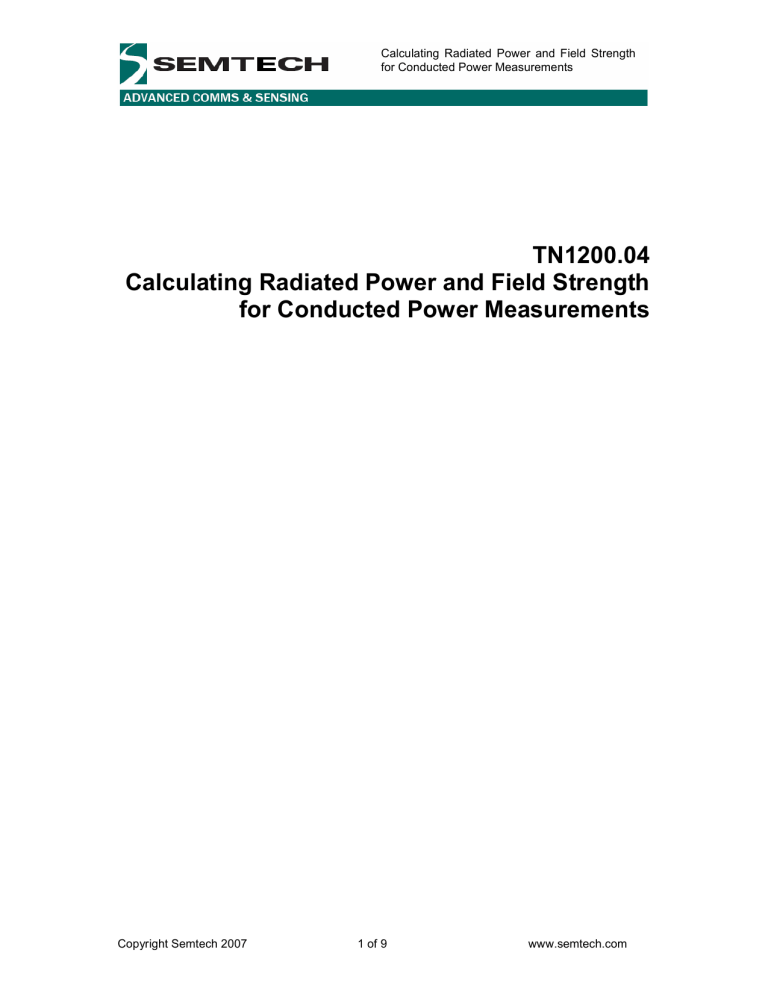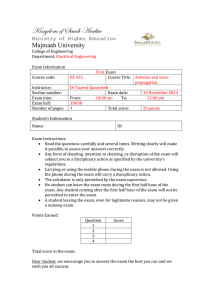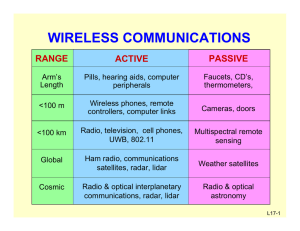TN1200.04 Calculating Radiated Power and Field Strength

Calculating Radiated Power and Field Strength for Conducted Power Measurements
TN1200.04
Calculating Radiated Power and Field Strength for Conducted Power Measurements
Copyright Semtech 2007 1 of 9 www.semtech.com
Calculating Radiated Power and Field Strength for Conducted Power Measurements
1 Table of Contents
1 Table of Contents............................................................................................................................. 2
1.1
Index of Figures ..................................................................................................................... 2
2 Introduction ...................................................................................................................................... 3
3 Antennas and Power Density .......................................................................................................... 3
3.1
Isotropic Antennas ................................................................................................................. 3
4 Free Space Path Loss ..................................................................................................................... 5
5 Antenna Coefficients........................................................................................................................ 6
5.1
Antenna Correction Factor..................................................................................................... 6
5.2
Antenna Factor ...................................................................................................................... 7
6 Field Strength Conversions ............................................................................................................. 7
7 Effective Isotropic Radiated Power Conversion .............................................................................. 8
8 References....................................................................................................................................... 9
1.1 Index of Figures
Figure 1: Isotropic Radiator..................................................................................................................... 3
Figure 2: One-Way Communications Link .............................................................................................. 5
Copyright Semtech 2007 2 of 9 www.semtech.com
Calculating Radiated Power and Field Strength for Conducted Power Measurements
2 Introduction
The Federal Communications Commission (FCC) Regulations for Radio Frequency Devices defines power and radiated limits in terms of electric field strength measured in volts/meter (typically at a distance of 3 meters) from the source.
Unless the engineer has access to a RF anechoic chamber, GigaHertz transverse electromagnetic
(GTEM) cell, or open area test site (OATS), most measurements will be made as conducted power measurements into the 50
Ω
load presented by the test equipment.
This application note will explain the relationship between conducted power levels and radiated power field strengths.
3 Antennas and Power Density
3.1 Isotropic Antennas
Since we are concerned with the radiated field generated from the antenna, we will consider the point source radiator or isotropic antenna. The performance of most practical antennas is often referenced in terms of this basic radiator.
The isotropic antenna radiates energy equally in all directions; hence the radiation pattern in any plane is circular, as illustrated below in Figure 1.
O r
Q
S
Figure 1: Isotropic Radiator
In the case of the isotropic radiator at point O which is fed with a power P watts. The power flows outwards from the origin and must flow through the spherical surface, S, of radius, r.
We can define the power density, P d
, at the point Q as:
P d
=
P
4
π r 2
Watts/m
2
(1)
Copyright Semtech 2007 3 of 9 www.semtech.com
Calculating Radiated Power and Field Strength for Conducted Power Measurements
Poynting’s theorem defines the relationship between the power density to the E-field and H-field vectors as defined below:
P d
=
E
×
H Watts/m
2
The magnitude of the power density is thus:
| P d
|
=
EH
=
E
2
120
π
, where 120
π is the impedance of free space or approximately 377
Ω
.
From the above, we can see that
E
H
=
120
π
, and thus,
E
120
π
=
P
4
π r 2
Hence, the rms value of the E (or Electric) field can be calculated from:
E
=
30 P
V/m (2) r
The isotropic antenna is considered to have a power gain, G i
= 1. Referring to Figure 1, above, if an antenna with gain G
T
were placed at point O, the power received at point Q would be increased by
G
T
. Hence, the field strength at point Q will be increased:
E
=
30 P
T
G
T
V/m r
Where P
T
is the transmitter power, G
T
is the antenna gain.
Similarly, for an antenna with gain G
T
, we can rewrite equation (1) as:
(3)
P d
=
P
T
G
T
4
π r
2
Watts/m
2
(4)
If G
T
= 1 (e.g. the gain of an Isotropic antenna with gain, G i
), the radiated power calculated in equation
(4) is referred to as the Effective Isotropic Radiated Power (EIRP) and is the power that would be radiated from a transmitter of Power P
T
from an ideal omnidirectional source.
Re-arranging (3), and with G
T
= 1, we can determine the EIRP in terms of the field strength:
P
T
=
E
2 r
2
(5)
30
As an example, FCC Part 15.249(a) states that the maximum field strength for ISM band devices operating in the 902 – 928 MHz band is 50 mV/m. Since field strength is typically measured at 3 m, we can rewrite (5) to calculate the EIRP as follows:
P
P
T
T
=
=
0 .
3 E
2
0 .
75 mW
= −
1 .
25 dBm
Copyright Semtech 2007 4 of 9 www.semtech.com
Calculating Radiated Power and Field Strength for Conducted Power Measurements
4 Free Space Path Loss
Consider the one-way (or simplex) communications link illustrated below in Figure 2: r
Q
T
Figure 2: One-Way Communications Link
Assume that a transmitter at T with transmitter power P
T
and antenna gain G
T
. The power density, P d
, at the receiver, Q is as previously defined in equation (4).
P d
=
P
T
G
T
4
π r
2
Watts/m
2
The radiated power received at the antenna port is a function of the effective aperture of the antenna:
A e
=
G ant
4
π
λ 2 m
2
If the gain of the receiver antenna, G ant
= G
R
, we can calculate the power received as:
P
R
=
P d
A e
P
R
=
P
T
G
T
G
( 4
π r
R
)
2
λ 2
(6)
(7)
(8)
Equation (8) is often referred to as the free space loss equation.
Whilst we can re-arrange (8) to determine the theoretical transmission range, it should be noticed that in the real world situation, factors such as reflections, scattering, shadowing, terrain and environment will impact upon the transmission range.
Copyright Semtech 2007 5 of 9 www.semtech.com
Calculating Radiated Power and Field Strength for Conducted Power Measurements
5 Antenna Coefficients
5.1 Antenna Correction Factor
Typically laboratory based power measurements are made with test equipment that has a characteristic impedance of 50
Ω
. As has been defined above, the characteristic impedance of free space is (120
π
)
Ω
or 377
Ω
.
For an antenna matched to a load, we can re-write equation (7) as
P
L
=
P d
A e
(9)
If P
L
is measured in a 50
Ω
load and P d
in a free space impedance of 377
Ω
, then the following relationships apply:
P
L
=
V
L
50
2
and P d
=
E 2
377
Hence, we can re-write equation (9):
V
L
50
2
=
E
2
377
A e
(10)
(11)
Note that V
L
2 units of m
2
is in units of volts, whilst E
2
is in volts/meter. The effective aperture of the antenna, with
, converts free space power density to circuit power.
The relationship between radiated and conducted power can be made clearer by defining an antenna correction factor (ACF), which is introduced in equation (12):
E
2
ACF
=
V
L
2
m
-2
Re-writing (11) and substitute for ACF:
ACF
=
377
50
1
A e
(12)
By substituting equation (6) into the above, the antenna correction factor can be defined as:
ACF
=
377
50
4
G ant
π
λ
2
m
-2
(13)
If the frequency, f, is in MHz, then by substituting
λ
=c/f:
ACF
ACF
=
=
377
50
4
π
(
1 .
03
×
10
3
10
12
(
3
×
10
8
2
)
( f , MHz
)
2
) ( f , MHz
)
2
1
G ant
G
1 ant
Copyright Semtech 2007 6 of 9 www.semtech.com
Calculating Radiated Power and Field Strength for Conducted Power Measurements
Taking 10(log) of both sides allows the ACF to be calculated in dB:
ACF ( dB )
= −
29 .
78 dB
+
20 log( f , MHz )
−
10 log( G ) (14)
5.2 Antenna Factor
From the above, we see that the Antenna Correction Factor links power (in terms of V
L
2
/R) and power density. Most antennas used for field strength and compliance measurements use a coefficient to link field strength E to receiver voltage V directly, since V
L
can be measured, whilst E is the quantity that is required by the FCC.
This coefficient is a called Antenna Factor (A
F
1/
λ
).
) and is generally quoted as a function of frequency (or
A
F
=
E
V
L
A
F
=
=
E
2
V
L
2
=
ACF
377
50
G
4 ant
π
λ
2
=
λ
9 .
73
G ant
m
-1
(16)
6 Field Strength Conversions
From equation (9) the power in the load is related to power density by the effective antenna aperture,
A e
. Substituting equation (6) into this equation, we can relate load power directly to E as defined in equation 10, as follows:
P
L
=
λ
2 G ant
4
π
E
377
2
If the frequency, f, is in MHz and we substitute for
λ
=c/f:
P
L
=
( f ,
( 3
×
10
8
)
2
G ant
MHz )
2
( 10
6
)
2
E
4
π
2
377
For power in mW and field strength in
µ
V/m, and calculating the constant terms:
P
L
( mW )
=
1 .
90
×
10
−
8
G ant
( f ,
( E
MHz )
,
2
µ
V / m )
2
Taking 10(log) of both sides:
10 log( P
L
, mW )
= −
77 .
2 dB
+
10 log( G ant
)
+
20 log( E ,
µ
V / m )
−
20 log( f , MHz )
By rearranging the above:
E ( dB
µ
V / m )
=
P
L
( dBm )
+
77 .
2 dB
+
20 log( f , MHz )
−
G ant
( dB )
(17)
(18)
Copyright Semtech 2007 7 of 9 www.semtech.com
Calculating Radiated Power and Field Strength for Conducted Power Measurements
Since P
L
is related to power measured in a circuit (by using a spectrum analyzer) by the terms for any path gains between the antenna and the analyzer, we can rewrite P
L
= P meas
– P gain
. Equation (18) becomes:
E ( dB
µ
V / m )
=
P meas
( dBm )
−
P gain
( dB )
+
77 .
2 dB
+
20 log( f , MHz )
−
G ant
( dB ) (19)
Equation 19 is the key equation for converting power measured in a circuit (in dBm) into incident field strength in dB
µ
V/m.
7 Effective Isotropic Radiated Power Conversion
To calculate the effective EIRP from the power measured in a circuit, from equation (7), the power in the receiver is related to the power density and the effective aperture of the antenna:
P
R
=
P d
A e
=
A e
P
T
G
T
4
π r
2
=
A e
| EIRP
4
π r
2
|
(20)
From equation (6), the effective aperture of the antenna is the effective aperture of an isotropic antenna multiplied by the gain of the antenna (G ant
= G
R
):
A e
=
G
R
4
π
λ
2
Taking log(10) of both sides of equation (20), and if the frequency, f, is in MHz, distance, r, is in meters, and substituting for
λ
=c/f:
P
R
=
EIRP
+
G
R
( dB )
+
27 .
5
−
20 log( f , MHz )
−
20 log( r , meters ) (21)
For the measurements required by FCC Part 15, equation (21) is a convenient method of calculating the power in the receiver.
Since measurements are typically made at a distance of 3 meters, we can rewrite equation (21):
P
R
=
EIRP
+
G
R
( dB )
+
17 .
96
−
20 log( f , MHz ) (22)
If the gain of the receiver antenna is known and the received power has been measured at a distance of r meters from the source, we can rearrange equations (21) and (22) to calculate the EIRP:
EIRP ( dBW )
=
P
R
( dBm )
−
G
R
−
57 .
5
−
20 log( f , MHz )
−
20 log( r , meters ) (23)
If EIRP relative to 1 mW is required:
EIRP ( dBm )
=
P
R
( dBm )
−
G
R
−
27 .
5
−
20 log( f , MHz )
−
20 log( r , meters )
And assuming that the distance r is 3 m as in the case defined for equation (22):
EIRP ( dBm )
=
P
R
( dBm )
−
G
R
−
37
−
20 log( f , MHz )
(24)
(25)
Copyright Semtech 2007 8 of 9 www.semtech.com
Calculating Radiated Power and Field Strength for Conducted Power Measurements
8 References
•
F.R. Connor; “Antennas” Edward Arnold, 1972
•
Softwright LLC; http://www.softwright.com/faq/faq_engineering.html
)
•
F. Sanders; “Conversion of Power Measured in a Circuit to Incident Field Strength and
Incident Power Density, and Corrections to Measured Emission Spectra for Non-Constant
Aperture Measurement Antennas” (Appendix C of NTIA Report 01-383, Jan 2001)
END OF DOCUMENT
Copyright Semtech 2007 9 of 9 www.semtech.com





